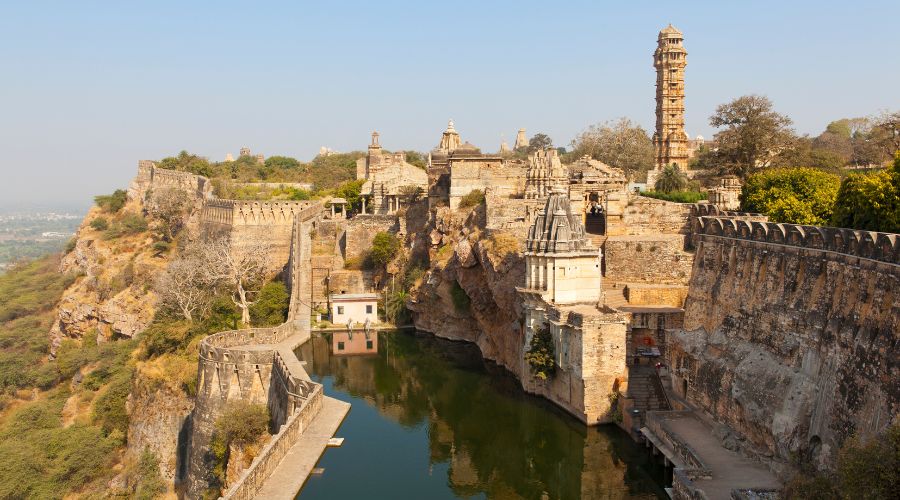6 World Heritage Hill Forts of Rajasthan, India
The serial site, situated in the state of Rajasthan, includes six majestic forts in Chittorgarh; Kumbhalgarh; Sawai Madhopur; Jhalawar; Jaipur, and Jaisalmer, were included in the UNESCO World Heritage Site in 2013. They were recognized as a serial cultural property and examples of Rajput military hill architecture.
The ecclectic architecture of the forts, some up to 20 kilometres in circumference, bears testimony to the power of the Rajput princely states that flourished in the region from the 8th to the 18th centuries.
- Jaisalmer Fort at Jaisalmer city
- Kumbhalgarh Fort at Rajsamand city
- Chittor Fort at Chittorgarh city
- Amer Fort at Jaipur city
- Ranthambore Fort at Sawai Madhopur
- Gagron Fort at Jhalawar city
View on Google Map
Jaisalmer Fort at Jaisalmer city

Jaisalmer Fort is situated in the city of Jaisalmer. It is believed to be one of the very few “living forts” in the world, as nearly one fourth of the old city’s population still resides within the fort.
Jaisalmer Fort is the second oldest fort in Rajasthan, built in 1156 AD by the Rajput Rawal Jaisal and stood at the crossroads of important trade routes.
The fort’s massive yellow sandstone walls are a tawny lion colour during the day, fading to honey-gold as the sun sets, thereby camouflaging the fort in the yellow desert. For this reason, it is also known as the Sonar Quila or Golden Fort.
The fort stands amidst the sandy expanse of the great Thar Desert on Trikuta Hill, its dominant hilltop location making the sprawling towers of its fortifications visible for many miles around.
Kumbhalgarh Fort at Rajsamand city

Kumbhalgarh, also known as the Great Wall of India, is a Mewar fortress on the westerly range of Aravalli Hills, built during the 15th century by Rana Kumbha, just about 48 km from Rajsamand city and 84 km from Udaipur City.
The fort is among the largest fort complexes in the world, built on a hilltop 1,100 m above sea level on the Aravalli range. Kumbhalgarh has seven fortified gateways, the frontal walls are 4.5m thick and perimeter walls that extend 36 km – making it among the longest walls in the world. There are over 70 temples within the fort, both Jain and Hindu Temples.
Chittor Fort at Chittorgarh city

The Chittorgarh, also known as Chittod Fort, is one of the largest forts in India, located in the southern part of the state of Rajasthan, 233 km from Ajmer, midway between Delhi and Mumbai . The fort was the capital of Mewar and is located in the present-day city of Chittorgarh. It sprawls over a hill 180 m in height and spread over an area of 280 ha.
It is situated on the left bank of the Berach river (a tributary of the Banas River) and is linked to the new town of Chittorgarh (known as the ‘Lower Town’) developed in the plains after 1568. The fort covers 65 historic structures, which include four palaces, 19 large temples, 20 large water bodies, 4 memorials and a few victory towers.
Amer Fort at Jaipur city

Amer Fort or Amber Fort is a fort located in Amer, Rajasthan, India. Amer is a town with an area of 4 square kilometres located 11 kilometres from Jaipur, the capital of Rajasthan.
Located high on a hill, it is the principal tourist attraction in Jaipur. Amer Fort is known for its artistic style elements. With its large ramparts and series of gates and cobbled paths, the fort overlooks Maota Lake, which is the main source of water for the Amer Palace.
This palace, along with Jaigarh Fort, is located immediately above on the Cheel ka Teela (Hill of Eagles) of the same Aravalli range of hills. The palace and Jaigarh Fort are considered one complex, as the two are connected by a subterranean passage. This passage was meant as an escape route in times of war to enable the royal family members and others in the Amer Fort o shift to the more redoubtable Jaigarh Fort.
Ranthambore Fort at Sawai Madhopur

Ranthambore Fort lies within the Ranthambore National Park, near the city of Sawai Madhopur in Sawai Madhopur district of Rajasthan.
The fort provides a panoramic view of the surrounding Ranthambore National Park . Inside Ranthambore fort, there are three Hindu temples dedicated to Ganesha, Shiva and Ramlalaji constructed in 12th and 13th centuries from red Karauli stone. There is also a Jain temple of Lord Sumatinath (5th Jain Tirthankar) and Lord Sambhavanath. It is widely believed that the construction of the Ranthambhore Fort was started during the reign of the Chauhan Rajput King Sapaldaksha in 944 AD.
Gagron Fort at Jhalawar city

Gagron Fort is a hill and water fort and is situated in Jhalawar district of Rajasthan. It was built by king Bijaldev Singh Dod in the twelfth century. The fort is the only fort in North India surrounded by water and has been named the Jaladurga (Water Fort) of India.
Gagron Fort is surrounded by water on three sides and a moat filled with water on the fourth side. It is constructed on the confluence of Ahu River and Kali Sindh River. A mausoleum of Sufi Saint Mitthe Shah just outside the fort is the venue for an annual colourful fair held during the month of Muharram. There is also a monastery of Saint Pipaji across the confluence.


